OspreyCam
Currently offline until April 2026. Please check back!
Enjoy Annie & Squam’s Journey in Real-Time
The OspreyCam, installed in 2018, has been streaming each nesting season ever since. Powered by solar energy, it transmits wirelessly to Lobsta Land Restaurant in Gloucester, and from there, out to the world. The stream runs daily from approximatley 6:00am to 6:00pm.
We hope you enjoy the 2025 Osprey season with Annie & Squam as they embark on another nesting journey in Northeast Massachusetts! Watch their incredible story unfold in real-time as they navigate this season together.
Please note: occasional interruptions may occur during extended cloudy periods when the solar batteries can’t fully recharge. We appreciate your patience—streaming will resume as soon as possible. Thank you for watching!
If you have questions, please contact Dave Rimmer, Osprey Program Director.
Donate to Support Greenbelt’s OspreyCam Email Your Questions
2025 Nesting Season Updates
Submitted by Dave Rimmer, Osprey Program Director
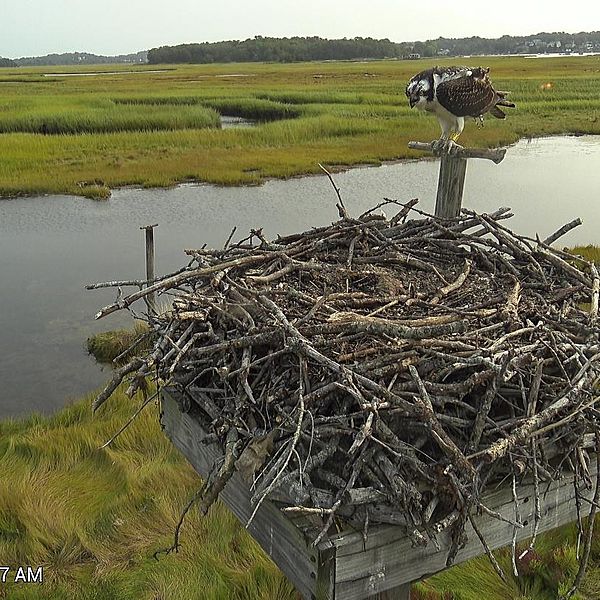
Update #25
Posted 9/27/25
Greetings for perhaps the final time in 2025. It has been about a month since my last blog entry and since then Kate and Ed have left the nest for good, with their last sighting on or about Sep 8. The…
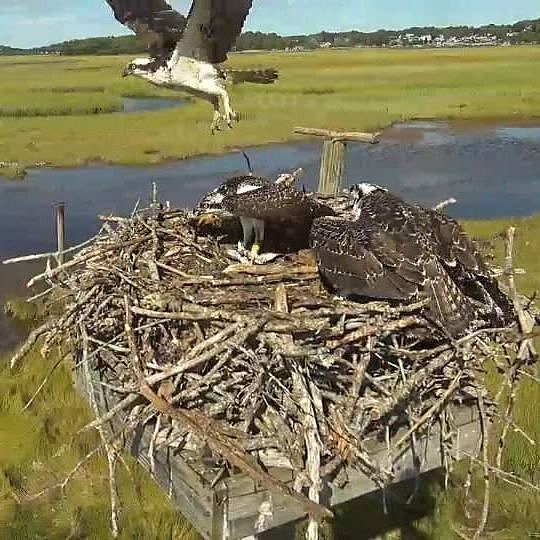
Update #24
Posted 8/26/25
My most recent blog post was not entirely accurate. Today I saw Squam at the nest, as did a few other viewers who brought it to my attention. See the attached photo with squam flying off. It was a…
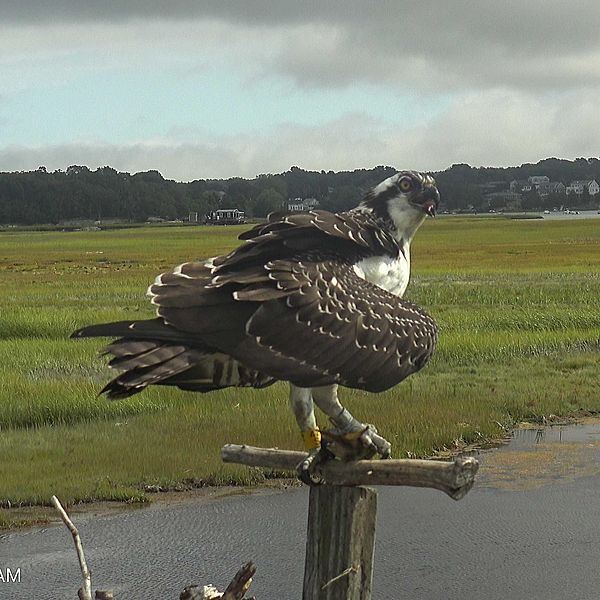
Update #23
Posted 8/22/25
Kate and Ed remain steadfastly on the nest at Lobstaland. Here is my take on what is going on of late. I believe that Annie and Squam have left the nest and their two fledglings. Based on my review of…

Update #22
Posted 8/1/25
This morning, I was alerted that one of the fledglings at the webcam nest — either Ed or Kate — had something tangled around its right foot and talons, as seen in the photo. It was a combination of…
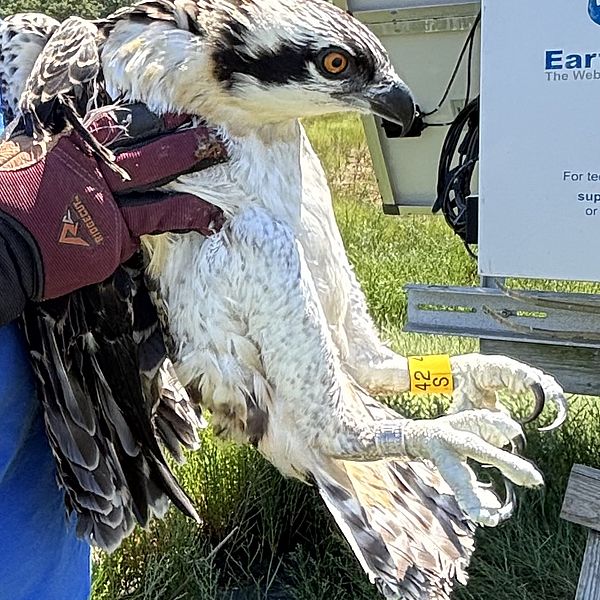
Update #21
Posted 7/22/25
It has been a bit since my last blog, mostly because it has been business as usual for Annie, Squam, Kate and Ed. The chicks are still pre-fledglings and are now about 40+ days old. The are starting…
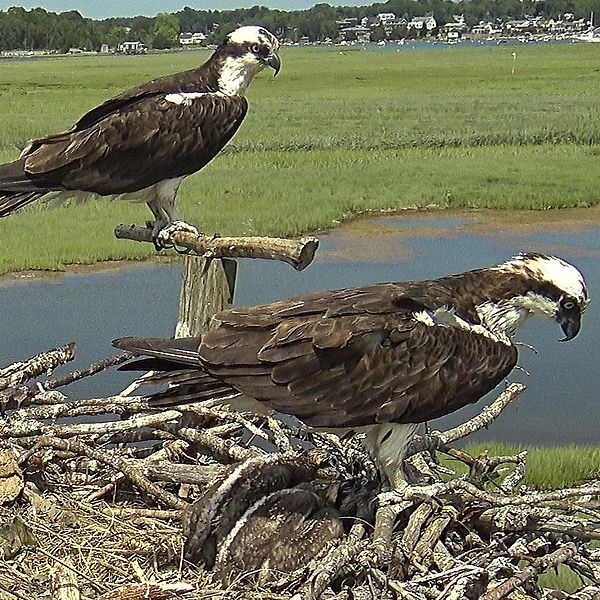
Update #20
Posted 6/30/25
In honor of Greenbelt's most recent (now retired) presidents, the two feather balls being raised by Annie and Squam will go by the names of Ed (Becker) and Kate (Bowditch). Ed and Kate are now 20 days…
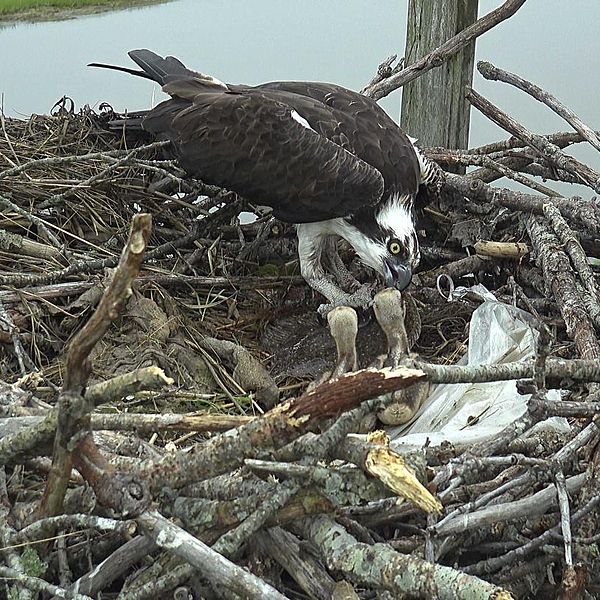
Update #19
Posted 6/18/25
It looks like only two of the three eggs have hatched for Annie and Squam. Visibility into the nest is limited due to a few sticks blocking the view, but from what we can see, there appear to be two…
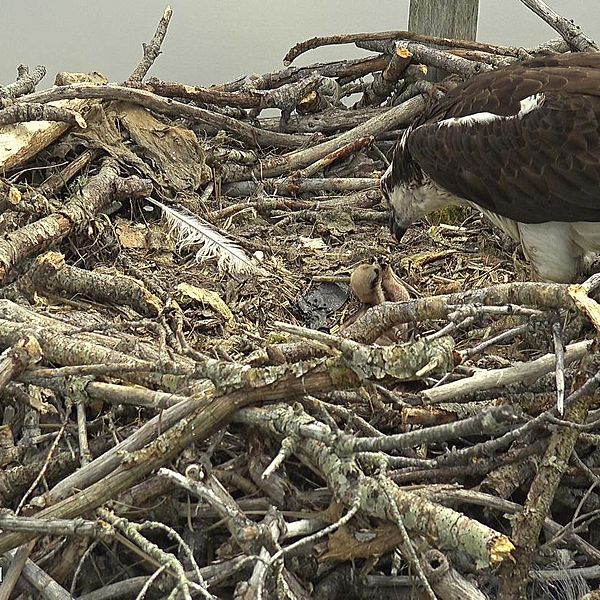
Update #18
Posted 6/13/25
It’s arguably the busiest week of the year at Greenbelt — our annual Art in the Barn show is in full swing at the Cox Reservation in Essex, and it’s truly an all-hands-on-deck effort. As a result, I…
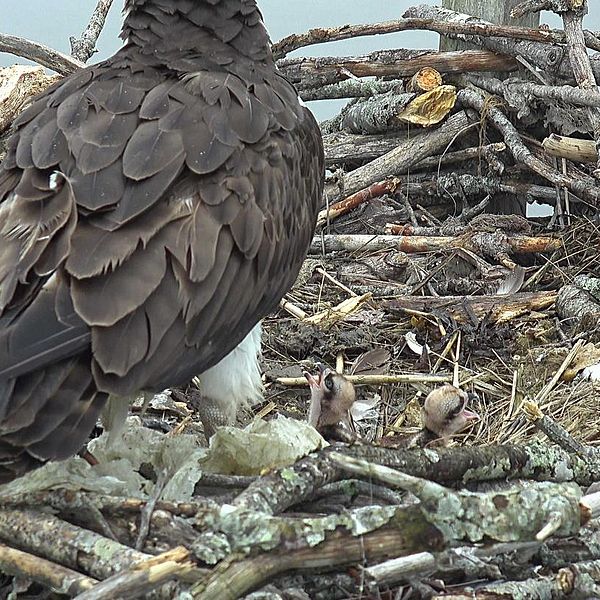
Update #17
Posted 6/10/25
Just like clockwork, 2 of the 3 eggs Annie laid starting on April 30, and she and Squam have been incubating for about 40 days, have hatched in the last 24 hours. Fingers and toes are crossed that the…
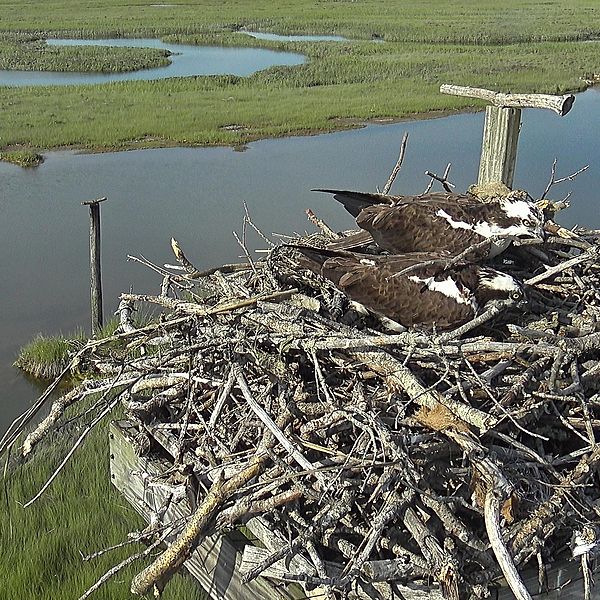
Update #16
Posted 6/4/25
Time flies and somehow it has been over 2 weeks since my last blog post. However, there is not much “new news,” meaning all is well with Annie and Squam as they move towards the hatching date for…
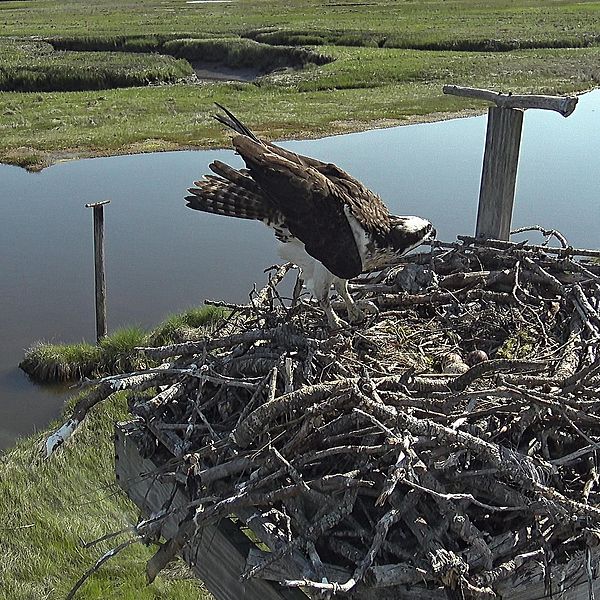
Update #15
Posted 5/14/25
The camera recorded a good photo this morning of all three eggs intact in the nest (photo attached). It is a better photo than 2 days ago and allays any concerns eggs were damaged by the banded male…

Update #14
Posted 5/12/25
All is well with Annie and Squam, despite some excitement which involved the same banded male Osprey from earlier in the season visiting the nest recently. I did not personally witness him or see…

Update #13
Posted 5/6/25
Great news! Annie now has 3 eggs in her clutch. I am not 100% sure if the 3rd egg came late yesterday or today, but if today, that is a 7 day span between egg #1 and egg #3. This is not anything…
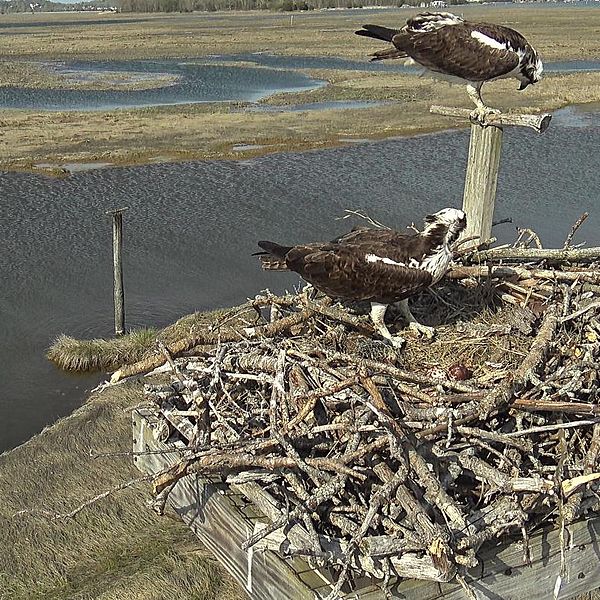
Update #12
Posted 5/4/25
Annie laid her 2nd egg on May 3. Both eggs are visible in the photo. Let's hope for a 3rd egg tomorrow.

Update #11
Posted 4/30/25
Annie laid her first egg early this morning! The photo included with this post was taken at 6:02am, confirming that my bold prediction yesterday — an egg before the end of April — was spot on. Phew!…

Update #10
Posted 4/29/25
No eggs yet for Annie and Squam, but it’s only a matter of time. Last year, the first egg arrived on April 27, so I fully expect Annie to lay her first egg any day now—likely before the end of April.…
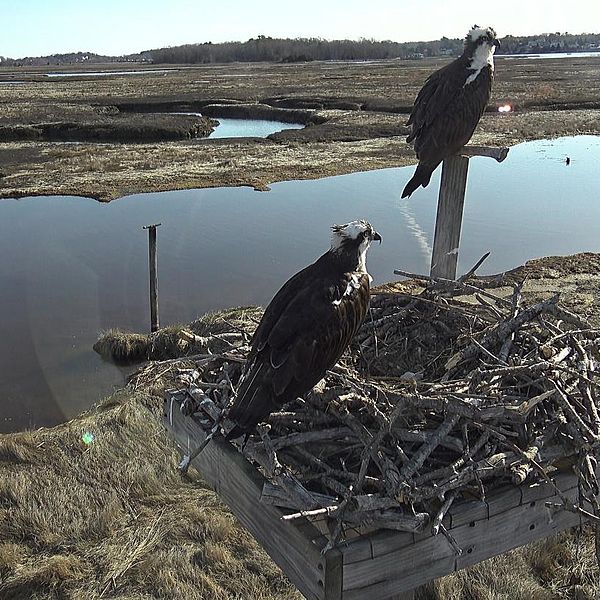
Update #9
Posted 4/21/25
My apologies for the gap in blog entries… I was on vacation and traveling most of last week. I was checking in on Annie and Squam’s activity from afar, and like all of you, what I observed was a lot…
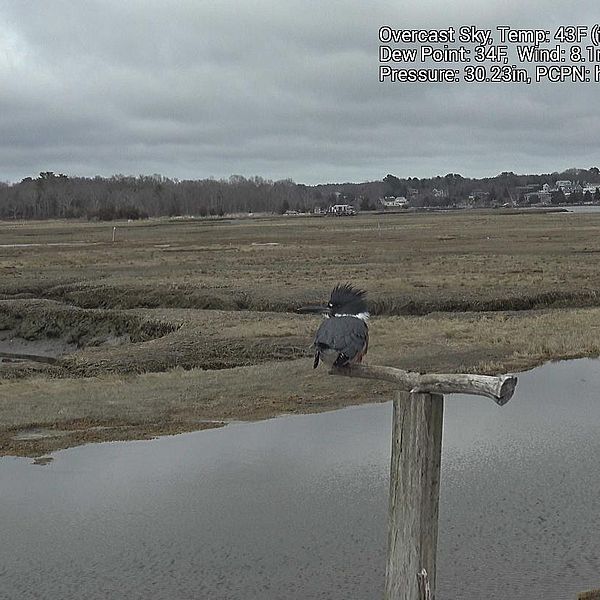
Update #8
Posted 4/11/25
As I sit here at my computer late on a Friday afternoon, I feel that I can state with a high level of confidence that Annie and Squam have reunited. They are already building up the nest together and…
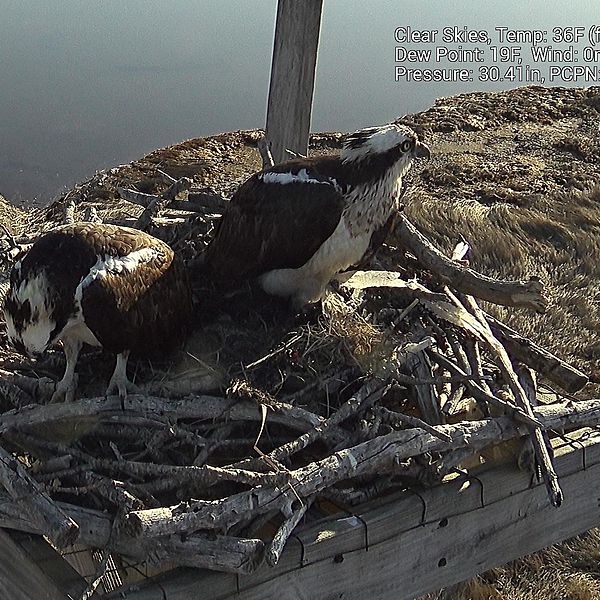
Update #7
Posted 4/10/25
It appears that Squam is back on the nest with Annie. Phew! I base this on seeing Annie and an unbanded Osprey on the nest.. it has to be Squam. The accompanying photo shows Annie on the right with…
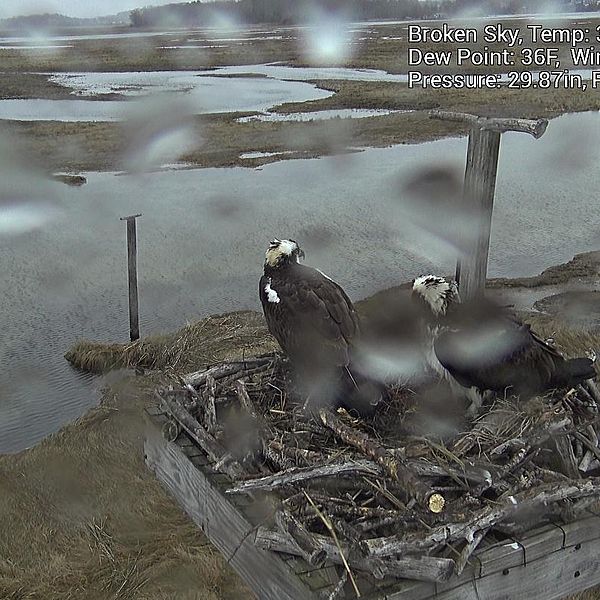
Update #6
Posted 4/7/25
Unfortunately, the persistent cloudy weather has prevented the solar-powered webcam batteries from charging. As a result, aside from a brief period this morning, the camera has not been streaming, and…
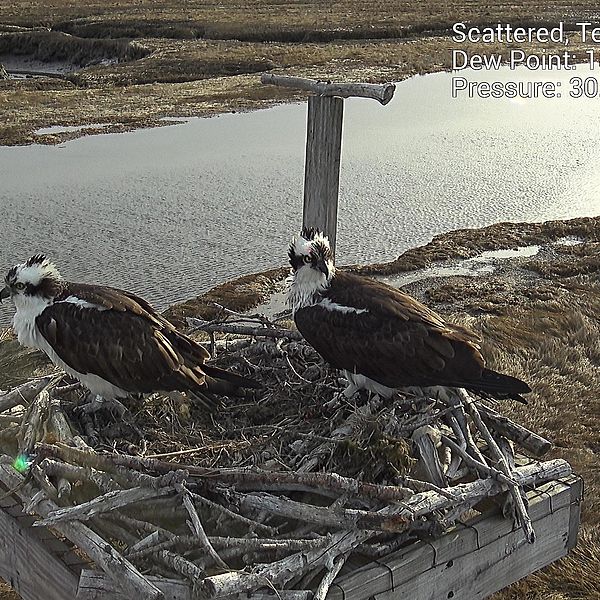
Update #5
Posted 4/2/25
Based on my own observations of activity on this nest, I do not think Squam has arrived yet. I have only seen Annie and the banded male at the nest so far, including today (see photo with banded male…

Update #4
Posted 3/31/25
I am sure many of you noticed that the webcam was not streaming much this past weekend. The entire system is solar-powered, and when there are consecutive days of heavy cloud cover, the batteries do…
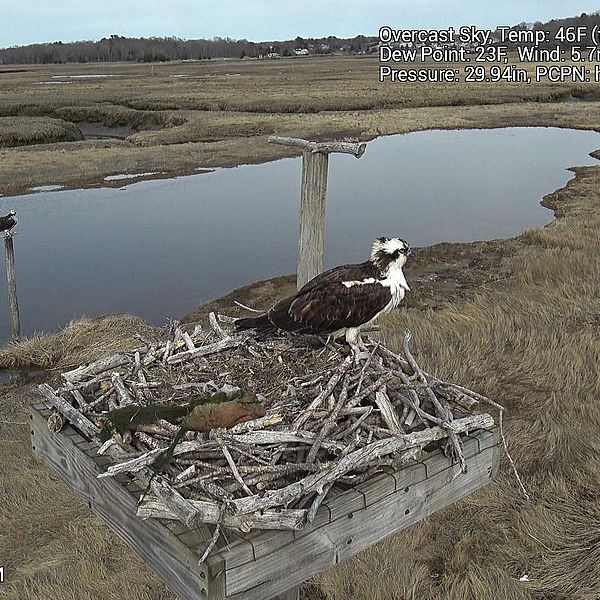
Update #3
Posted 3/26/25
Today, March 26, we are witnessing a repeat of the past 2 years, with Annie returning and being greeting by a banded intruding male Osprey that I assume is the same one from previous years. He started…
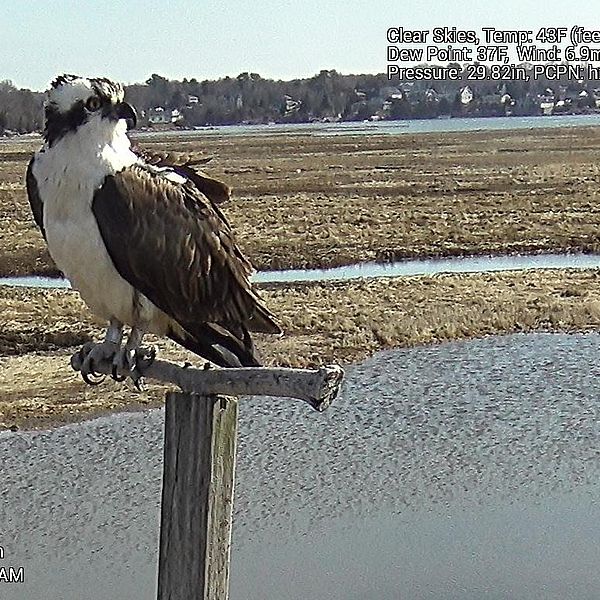
Update #2
Posted 3/25/25
As some of you have undoubtably seen, there has been some activity on the nest as of yesterday (3/24/25) morning, when 2 different Osprey were observed - one unbanded and one banded. Thus far today,…
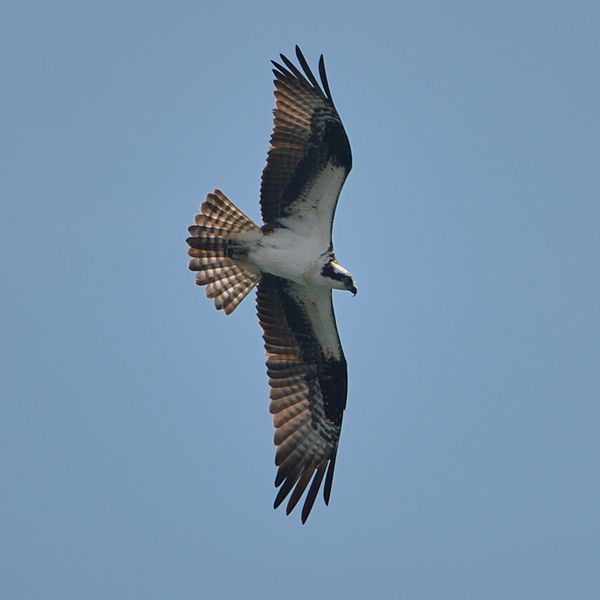
Update #1
Posted 3/20/25
Welcome back for another year of Osprey watching on Greenbelt’s webcam, set up on an active nesting platform in Gloucester, Massachusetts. The webcam was installed today - March 20, and we hope to…
2024 Nesting Season Updates
Read Blog Posts from the 2024 Season
Update #20 – Sep 11, 2024 – The 2024 nesting season for Annie and Squam has concluded and despite our best efforts, we have not been able to reconnect the webcam. We will be removing the equipment soon and regrouping for 2025.
In summary, it was a very successful year for this pair. Everything went basically according to plan except I believe they failed producing a second egg, so the actual second was laid 5 days after the first egg, and really should have been a third egg. Regardless, the 2 eggs hatched only a few days apart, and despite a size difference for much of the time, they both grew and flourished, were banded and eventually fledged. I have not seen an Osprey on the nest for a week or more now, so I think all family members have left the nest site for the season. We will eagerly await the return of Annie and Squam nest spring.
Around the region, it was an amazing season and very successful. Greenbelt relies on our dedicated volunteer community scientists to monitor nests and report activity via the Greenbelt website. In 2024, over 1800 online reports were submitted. When the dust had settled, we confirmed 90 breeding pairs of Osprey from East Boston to Salisbury and inland to Merrimac, Haverhill and Boxford. That is a 10 pair increase from 2023. We confirm 141 fledglings this year and banded 35 of them as 4-6 week old chicks. There appeared to be plentiful forge for the adult Osprey, and unlike 2023, we did not observe any malnutrition or starvation among chicks we monitored.
Some other numbers:
- 67% of breeding pairs (60/90) successfully raised young
- 8% of breeding pairs (8/90) were non-egg laying housekeeping pirs
- 22% of breeding pairs (20/90) failed to hatch eggs or raise young
- 2% of breeding pairs (2/90) had an unknown fate
- Average fledglings per nest was 1.57 (141/90)
- Nest types:
- Platforms = 61
- channel markers = 13
- phone poles/light tower = 10
- hunting blinds/roofs = 3
- trees = 3
Update #19 - August 23, 2024 - We have been trying relentlessly and unsuccessfully so far to troubleshoot the webcam issues with Earthcam, who sold us the equipment and hosts our live stream. Very challenging to have to hike across 1000+ feet of salt marsh to try something and not have it work. We are going to try one more thing next Monday, and if that fails to get the webcam operational, we will be removing the equipment for the year and sending the camera back to EarthCam for inspection.
As of yesterday, I did see one of the fledglings still at the nest. This is consistent with past years when 1 or more fledglings often stayed in the nest into early September.
I have spent time this week looking very carefully at all the data for active nests in our region, and it looks like we had 89 active breeding pairs in 2024. There were 59 successful pairs that fledged young, 8 pairs that were housekeepers (no eggs just a nest), 20 pairs that failed for some reason and 2 pairs with an unknown outcome. Collectively the 89 pairs produced 140 fledglings and we banded 35. Comparatively, in 2023 we observed 80 breeding pairs and in 2022 we observed 75 breeding pairs. So there was a 9 pair (11%) increase from 2023 to 2024. Impressive!!
********************
Update #18 - August 16, 2024 - We are still unable to get the webcam streaming, so it may be that we have to remove the equipment and reset everything for next year. Not sure. Stand by. We are not giving up yet but just unable to pinpoint the issue.
I was at the nest yesterday and fledglings Mr. Big and Miss Little are still hanging around. They were flying overhead while I worked on the camera - screaming for me to leave them alone!! I did not see Squam but he may be around too or off hunting. I am quite sure that Annie has departed the nest and is beginning her winter break!
**********************
Update #17 - August 14, 2024 - We are still trying to troubleshoot why the webcam is not operational. We are making every effort to get it back up and streaming before we remove the equipment in September. Thanks everyone for your patience.
Update #16 - August 10, 2024 - As many of you can see, there are currently some technical issues with the webcam. We are trying to resolve them and hope to have the live stream back up asap. Thanks for your patience.
***********************
Update #15 - July 26, 2024 - Today was the first time I witnessed one of the nestlings take a flight. It flew over to the side perch and then eventually back to the nest when Squam delivered a fresh fish. I have not yet seen both nestlings/fledglings off the nest but for all intents and purposes, Mr. Big and Miss Little are now fledglings. Expect them to come and go from the nest over the next 2+ weeks.
You may also be noticing that these two are feeding themselves now. Today Squam just dropped off the fish and the youngsters had at it on their own. A good example of a skill they need to learn and develop to survive in the wild, and you can see it happen here in real-time. More importantly though, these two fledglings will need to learn to hunt on their own and find good day and night roosting spots away from the nest. So as time goes by, their absences will increase in time and frequency, until they leave the nest for good and start their wandering migration south.
Keep a look out for Annie. She may or may not have left already. As I have shared before, the adult female of a breeding pair basically leaves the family group as soon as the chicks fledge. She’s done nothing but incubate eggs and raise chicks for the past 100+ days and she is eager to move on and migrate south.
A quick look at my past data reveals that Annie and Squam raised their first chick to fledgling in 2019 and in total have now raised 14 fledglings. They are an absolute rock star Osprey pair!
****************************
Update #15 - July 17, 2024 – This morning, while the air temperatures were still relatively cool, we walked across the salt marsh with ladder in hand, turned off the webcam, and proceeded to lift Annie and Squam’s chicks, Miss Little (43 days old) and Mr. Big (46 days old), out of the nest one at a time to be banded. The process goes quickly and smoothly – I grab the chick and carry it down the ladder with me, then I hand it over to a second person, who holds the chick gently by clutching across its wings and body with legs facing outward. Next, I open up an aluminum USFWS band and place it carefully over the right lower leg above the foot, and using standard pliers, I close the band and clamp or lock it in place. We make note of the unique band number, and the chick is returned to the nest. From start to finish it takes 3-4 minutes.
There remains a noticeable size and weight difference between Miss Little and Mr. Big. But overall, both appeared very healthy and strong. You may recall that in 2023 there were concerns that food availability was impacting Osprey chick growth and survival in our region, something that does not appear to be a limiting factor at all in 2024. We banded 16 chicks on 7/16 in the Merrimack River area and 3 more today (7/17), and every one of them seemed very well fed. We avoid banding when it is too hot, so we are behind our normal pace of banding in 2024, meaning we will likely miss some opportunities as chicks fledge before we are able to band them as chicks.
As Miss Little and Mr. Big continue to grow and stand more, and even after they fledge but are still staying on the nest, the USFWS band on their right legs will be very visible. Rest assured the band is light and very smooth, resulting in no impact to the Osprey. Bird banding is a key tool in understanding bird movements and survivorship, which is why Greenbelt makes the effort.
*********************************
Update #14, July 11, 2024 - Mr. Big and Miss Little (39 and 36 days old respectively) are really getting big and more active in the nest. Their first set of primary feathers are filling in with beautiful shades of black, brown and white. And those orange eyes that they have their first year (until they turn yellow as adults) are prominent. They are also getting closer in size and harder to tell apart I find.
Today as I view them at 9am, both Annie and Squam are away from the nest. Annie is probably roosted nearby, taking a break and watching her chicks from afar. Squam is surely out hunting. Now at 9:13am, Squam just delivered what looks like a small flounder, and all four family members are in the nest!
Predicting when these 2 chicks will fledge is difficult but somewhere in the 50-60 day old range they will probably lift off for the first time. Expect to see them doing more wing flapping in the coming days and even facing into the wind with their wings open, just getting accustomed to the feel of wind under their wings.
Our plan is to try to band the 2 chicks sometime next week, at about the 6–7 week-old mark, so you may see some new “bling” on their right legs in the near future. Our chick banding efforts are part of a larger banding effort in MA (and the US) to understand chick survival rates and migration activities. Any banded bird would need to be in hand (alive or dead) to read the band numbers, but that is how we would know which bird it is, as every band has a unique number sequence. And all the banding data for all birds in the US is managed by the US Fish and Wildlife Service. So, band information is sent to them by the bander (me) each year and then any recovery is reported to them, prompting them to inform me of the recovery. Bird banding has revealed valuable data over many decades for almost all species of birds, from land birds to waterfowl to raptors like Osprey. Today, satellite and GPS transmitters provide even more detailed information, but it is a more expensive tracking method and transmitters are used in a small fraction of birds compared to bands.
Across the region, we are also seeing many chicks fledging or close to it, and we will be coordinating banding efforts at many nests we hope in the coming weeks. The goal would be to band 40-50 chicks if possible.
Keep enjoying these final weeks with Mr. Big and Miss Little!
**********************************
Update #13, June 26, 2024 - As we can all see with our own eyes, Mr. Big (23 days) and Miss Little (19 days) are really growing up fast. Unlike 2023, when there were concerns about food (fish) availability, and chick growth and development, these two are getting their daily fill and then some. They look super healthy and plump.
The chicks are starting to display the beginnings of actual Osprey plumage, and pin feathers are appearing, especially on their wings. What are pin feathers? Pin feathers are a term used to describe the emergence of new feathers in chicks or adults when mostly just the feather sheath shows. That is how a feather grows – out of the sheath.
These two chicks still have a long way to go – they are both about 3 weeks old and will not fledge until they are 7-8 weeks old. They are standing more and starting to stretch their wings some, all their natural process of strengthening their wings and legs. Annie is doing her best to shade the chicks on these hot days. And you will notice, as I just did today minutes ago, that the chicks will pant quite a lot, which is breathing with their mouths open and tongue out a bit to increase the surface area in their mouths for cooling purposes. Just about all animals do it. You will often see Annie and Squam panting.
For me these next 5 weeks are extremely exciting, watching the chicks grow into youngsters who will soon enough be flying on their own and learning how to survive as an Osprey in the wild. I suspect we will be able to distinguish Mr. Big from Miss Little by size even after they fledge, but Miss Little could catch up and even the tables. Something else to keep an eye on.
Around the region, Greenbelt’s Osprey nest monitors are submitting report after report of nests with chicks. And I took out a team yesterday and by boat we visited 17 active nests in Rowley and Ipswich. We observed 1-3 healthy looking chicks in 14 nests and found 3 failed nests (unknown reason). This means it is the busiest of times for the male Osprey, who is hunting for himself, his mate and their chicks, who have growing appetites. males with chicks to feed are probably catching 4-6 fish a day. Impressive! And the female is no less busy, tending to the chicks, shading them and feeding them.
I estimate we are still at about 85 breeding pairs of Osprey around the region.
*********************************************
Update #12, June 17, 2024 - By all accounts, Annie and Squam have two very healthy chicks they are feeding and protecting. Squam is delivering plenty of fish; Annie doing her usual bang up job of feeding the growing fluff balls. There is still a noticeable size difference between the two but both are growing nicely.
We have had some fun and interesting name suggestions. Thank you all for sending them in. We never know if they are male or female, so we generally have tried to select neutral names. But given the size discrepancy, the appropriate name choice for these two is going to be Mister Big and Miss Little. Not the most creative, but fun and easy. Eventually they may catch up to each other in size but certainly for the next 4-5 weeks they will be noticeably different.
In case you didn't know, female Osprey are larger than males on average - Annie is certainly bigger than Squam. So if Mister Big is male and Miss Little is female, Miss Little might outgrow Mister Big. It will be fun to watch.
This week ahead will certainly present some challenges with the forecast hot weather. One thing you will certainly notice, and you may have seen it already this year, is Annie and Squam shading the chicks by standing above them with her wings slightly outstretched, creating shade that helps keep them cool. Generation after generation of Osprey have evolved to deal with a wide range of environmental conditions and heat is one of them. I have confidence they will be OK.
For now, we get to enjoy watching these two chicks grow. They will become more active - standing more soon and moving around in the nest. Three weeks from now they will look less like chicks and more like young Osprey. It is a fun transition to watch.
Around the region, reports are coming in now of many nests with chicks. There have been a few nest failures (we never really know why), as well as some young pairs that started nests but never laid eggs and are now coming and going more from the nest. We call these young eggless nesting pairs "housekeepers". We probably have 6-8 pairs of them this year as part of the roughly 85 pairs I believe we have nesting across the region. We are still compiling the data on nesting pairs but it looks like another increase in 2024!
*******************************
Update #11, June 6, 2024 - The second egg hatched today, just three days after the first egg, even though the second egg was laid 7 days after the first egg. It is really fascinating to think that somehow there was some sort of compensation to shorten the incubation period for the delayed egg laying. Anyway, here we go with another window into the incredible parenting skills of Annie and Squam. Enjoy!
If you want to start thinking about names, please do. But we will let this first week or so play out for these two chicks before we issue their official names. There is a decent size difference between the chicks, and probably will be for a while, so distinguishing one from the other will not be difficult as we ponder names. I am sure we will get plenty of fun name suggestions.
**********************
Update #10, June 3, 2024 - The first egg hatched today right on schedule and moments ago (445pm) I watched, as some of you did too I am sure, Squam deliver a piece of fish and Annie feed the chick. Hooray!
******************
Update #9, May 31, 2024 - Today is Day 35 for incubation of Annie's first egg, but only Day 28 of her second egg. Hatching typically occurs at the 35-40 day timeframe, so we are anticipating the first egg to hatch any day now. What happens after that will be interesting to observe and I hesitate to even speculate about it at this point. However, I am hopeful that Annie and Squam will overcome this oddity of eggs laid a week apart, and somehow persevere to hatch and raise them both. Call it cautious optimism.
Around the region, a few of our Osprey monitors are reporting activity that suggests there are chicks in the nest. That is right on schedule, as the first nests to hatch eggs are usually in late May. Most pairs are still incubating eggs according to reports, but I expect to start hearing about sightings of adult Osprey feeding chicks in the coming weeks.
There have been a few interesting observations recently - the most newsworthy being that a pair of Osprey has been attempting to build a nest on the chimney of the Pink House along the Plum Island Turnpike in Newbury. This is most certainly a young pair building a nest for the first time, and their efforts have not been too impressive, resulting in most of the sticks falling onto the roof of the house or the ground. It is a small chimney that is not well suited for a nest site. The Pink House is owned by the US Fish and Wildlife Service (USFWS) and the abandoned house is scheduled to be relocated or removed in the coming year. Greenbelt has had discussions with the USFWS staff about placing a new Osprey platform in that area prior to the 2025 nesting season.
Another pair is trying to nest on a utility pole in Rowley and I am trying to work with the Rowley Light Dept on a strategy for this pair.
Finally, we installed new batteries in the webcam a few weeks ago and since then have not had a loss of power, despite a few consecutive cloudy days here and there. That was our goal, so we are pleased there have been no interruptions in the webcam live-feed since the new batteries were installed.
**********************
Update #8, May 21, 2024 - All is well at Lobstaland with Annie and Squam. There is not a lot to report these days as Annie incubates her eggs and Squam hunts for fish and delivers food to Annie. As I mentioned in past updates, the exact timing of hatching will be interesting to observe, since egg #1 was laid on/about April 26 and egg #2 on/about May 2-3. I would expect the first egg to hatch during the first week of June, with the second egg to follow approximately a week later. But I have never before observed such a span between eggs, so we will all have to wait and watch what happens. In 3 weeks or so, we will find out!
Around the region, Osprey are active at many sites from East Boston to Salisbury, and inland to Merrimac and Boxford and Haverhill. Numerous new nests have been found as well and so far, no real "problem" pairs, meaning pairs nesting in unwanted locations. Greenbelt's volunteer community scientist nest monitors are doing a fantastic job so far, submitting hundreds of reports on nesting pair activity already via our website. I could not keep track of all the nesting pairs - at least 80 again in 2024 - without their dedication and help.
******************
Update #7, May 9, 2024 - Today Annie and Squam still have a 2 egg nest, so it certainly appears that will be the extent of their egg laying this year. The first egg was laid on April 26 and the second May 2 or 3. I/we were all hoping for a third egg but I would be quite surprised at this point for a third egg to be laid so long after the first. As always we will keep a close eye on the nest.
Around the region, many pairs are on eggs now. Early indications suggest a similar number of pairs as 2023, when 80 pairs nested in the region. There are a few new nests but also a few that are not active after being active in 2023. Greenbelt's community scientist nest monitors are doing a fantastic job submitting reports, which is how I know exactly what is happening. ********************
Update #7, May 3, 2024 - This morning there was a second egg in the nest. And I assume Annie will lay a third egg too. It is quite unusual for there to be a full week between eggs. Time will tell how this will play out, but presumably there will be one chick with a significant head start on the others.
*********************
Update #6, April 27, 2024 - Yesterday Annie laid her first egg, one day later than 2023, so basically right on schedule. Very exciting and I could hear a collective sigh of relief from all the viewers. Thanks to all of you who sent emails to me about it. Keep them coming. Now we wait and watch and anticipate 2 more eggs over the next few days. Everything is trending in a positive direction!
Around the region, Osprey pairs are thriving everywhere. I spent some time in East Boston, Saugus and Revere with a volunteer nest monitor this past week, and the pairs in that area are active on platforms, utility poles and light towers. Amazing! And reports just keep pouring in via the Greenbelt website of active nests. ***********************
Update #5, April 19, 2024 - Annie and Squam are once again building a beautiful nest of sticks and grass, basically from scratch since I removed almost all the nest material at the end of last season due to the amount and weight. They are such seasoned pros now! Seeing Annie prepare the nest cup with soft grasses makes me think she is preparing it for eggs - soon! Last year the first egg appeared on April 25. So keep a close watch for that first egg in the next week.
Around the region, Osprey pairs are occupying old nests and building new ones more and more with each passing day. We have not completed a full review yet of all the active nest sites but my best guesstimate would be that about 70-80% of pairs are back on nests.
**********************
Update #4, April 9, 2024 - It is great news to see Annie and Squam back in the nest. YAHOO!! I am actually on vacation this week and not checking the webcam as often as I normally would. But I am getting emails from many viewers and I am checking in on the nest regularly. The banded male intruder has been seen but I am confident Squam will ward him off and this season's nest will start to grow and take shape. April is always an exciting month as the beginning of the nesting season takes shape.
*********************
Update #3, April 5, 2024 - I am sure many of you are wondering where Annie and Squam are? Good question which I do not have a great answer to, other than to say March was cold and wet, and early April has not been much better. There have been periodic sightings of a single Osprey on the nest and today there was a banded (right leg) male Osprey on the nest in the morning who was not Squam (who is not banded). The past 2 years there has been another male who has been present on and around the nest in the early part of the season, and this very well may be that same male. It does not seem that Annie or Squam have arrived back to the nest yet.
Across the region, Osprey are back on some nests but I believe that many birds are late in returning, perhaps due to the poor weather along the East Coast the last 2-3 weeks. The first 2 weeks of April are when we generally see most nests get reoccupied, so I am confident we will see a big increase in nest activity in the nest 2 weeks. And fingers are crossed that includes the webcam nest with Annie and Squam!
*********************
Update #2, March 27, 2024 - The camera has been streaming for almost a week now, and to my knowledge, it has not captured any images of Osprey on the nest. The cloudy conditions have also caused the batteries not to fully charge, so there have been some stretches where the video stream has gone down. However, looking closely at archived photos from last week and then again today, it is clear that some new nesting materials have been added to the nest. I assume this is Squam, but we did have a male intruder spend time at the nest early in the season the past 2 years, so it is possible he is responsible for the materials added to the nest. Time will tell. It is a positive sign there is some activity.
********************
Update #1, March 19, 2024 - Yesterday we installed the webcam and other equipment and today the video stream went live. Once again thanks to Corey Grammas, owner of Lobstaland Restaurant, for letting us connect the webcam stream through his modem/router. We couldn't do it with his support. Now we all just need to be patient and wait as Annie and Squam work their way north back to Gloucester.
